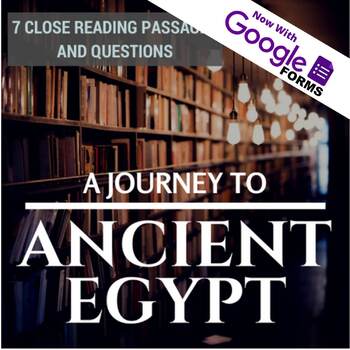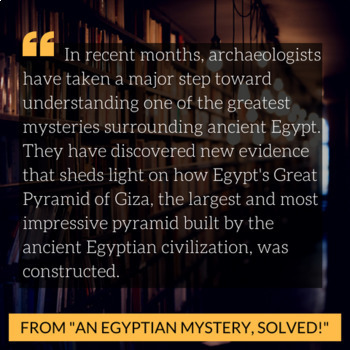A Journey to Ancient Egypt
- PDF
What educators are saying
Description
A Journey to Ancient Egypt consists of seven Ancient Egypt reading passages. Each passage includes 10 comprehension questions, and is differentiated at three Flesch-Kincaid text levels: Grade 3, Grade 5, and Grade 7. An answer key is included.
Passage 1: An Introduction to Ancient Egypt
In this informational text, students are introduced to the beginnings of ancient Egyptian civilization. They will learn about:
• The transition from hunter-gatherers to farmers
• The Red Land and the White Land
• King Menes and the capital city of Memphis
Vocabulary: Agriculture • Civilization • Fertile • Stationary • Unify
Passage 2: An Egyptian Mystery, Solved!
In this magazine article-styled text, students explore how new evidence has helped archaeologists to understand how the huge blocks of the Great Pyramid of Giza were transported. Students will learn:
• What is the Great Pyramid of Giza?
• Who built it and why?
• How did archaeologists gather evidence to formulate a new theory about the construction of the pyramid?
Vocabulary: Archaeologist • Century • Cylindrical • Quarry • Waterway
Passage 3: Tausret’s Problem
In this historical fiction narrative, students meet Tausret, the owner of an Egyptian pomegranate orchard. Students will explore:
• Daily life in ancient Egypt
• The role of women in ancient Egypt
Vocabulary: Orchard • Capital • Local • Import • Harvest
Passage 4: Would You Be Pharaoh?
In this persuasive text, students are asked to weigh the pros and cons of being pharaoh. Students will learn:
• Who the pharaoh was
• What the pharaoh’s roles and responsibilities were
• Interesting facts about several pharaohs
Vocabulary: Pharaoh • Hereditary • Absolute • Extravagant • Strike
Passage 5: Social Classes in Ancient Egypt
In this informational passage, students will explore the social classes of ancient Egypt. They will learn:
• Who belonged to each social class in ancient Egypt
• If people could move from one social class to another (social mobility)
• The relationship between class and religious beliefs in ancient Egypt
Vocabulary: Social Class • Luxury • Vizier • Noble • Social Mobility
Passage 6: Cracking the Code
In this informational passage, students will learn about hieroglyphics. They will study:
• How hieroglyphics differ from modern writing
• How hieroglyphics were translated
• How new discoveries can cause archaeologists to revisit old theories
Vocabulary: Adorn • Sarcophagus • Foreign • Hieroglyphics • Decipher
Passage 7: Iput and the Scorpion
In this historical fiction narrative, students will explore the relationship between medicine and religion in ancient Egypt through the story of Iput. Students will learn:
• How Egyptian religious beliefs overlapped with medicine
• The role women played in ancient Egypt as healers and priestesses
• The significance of the Egyptian goddess Serket
Vocabulary: Priestess • Serket • Mortar and Pestle • Medicinal • Invoke





